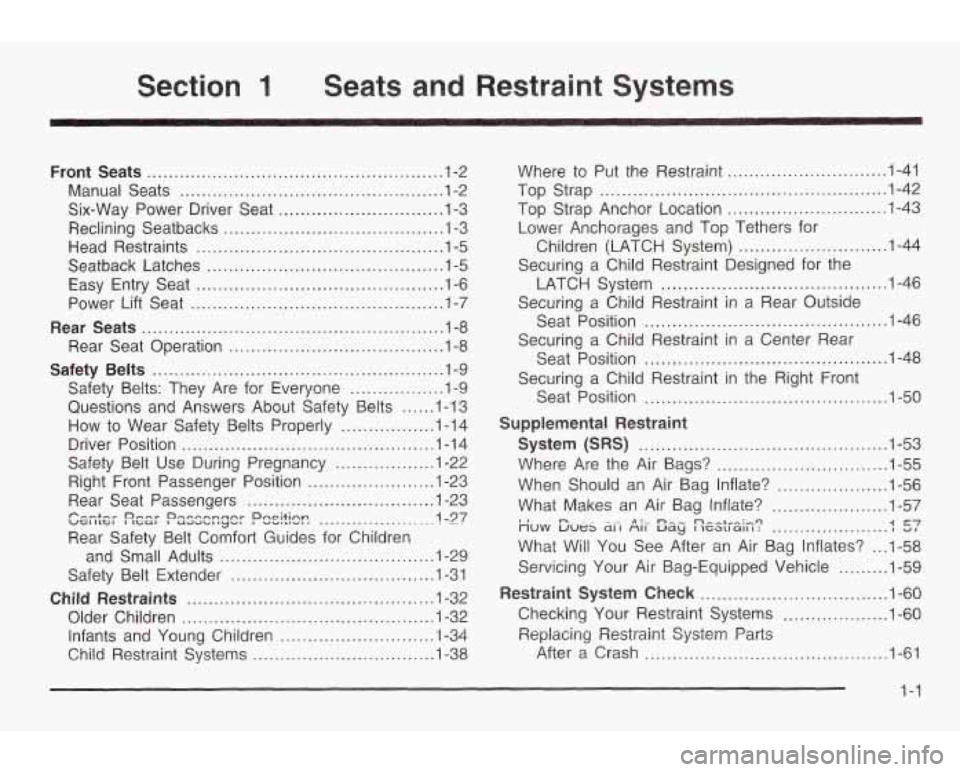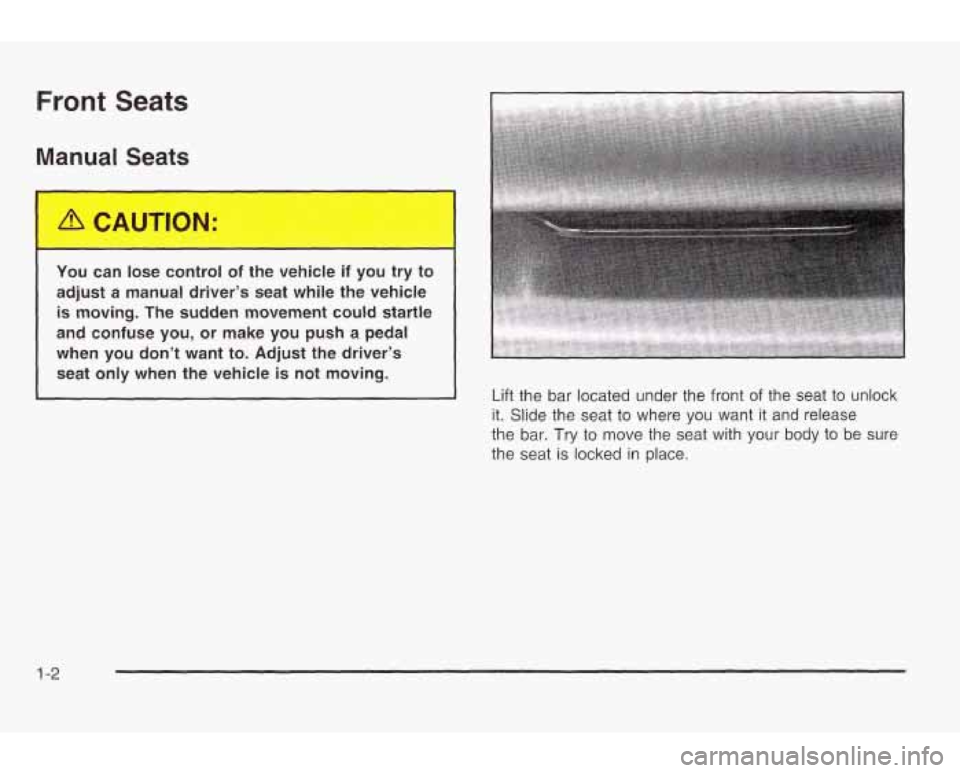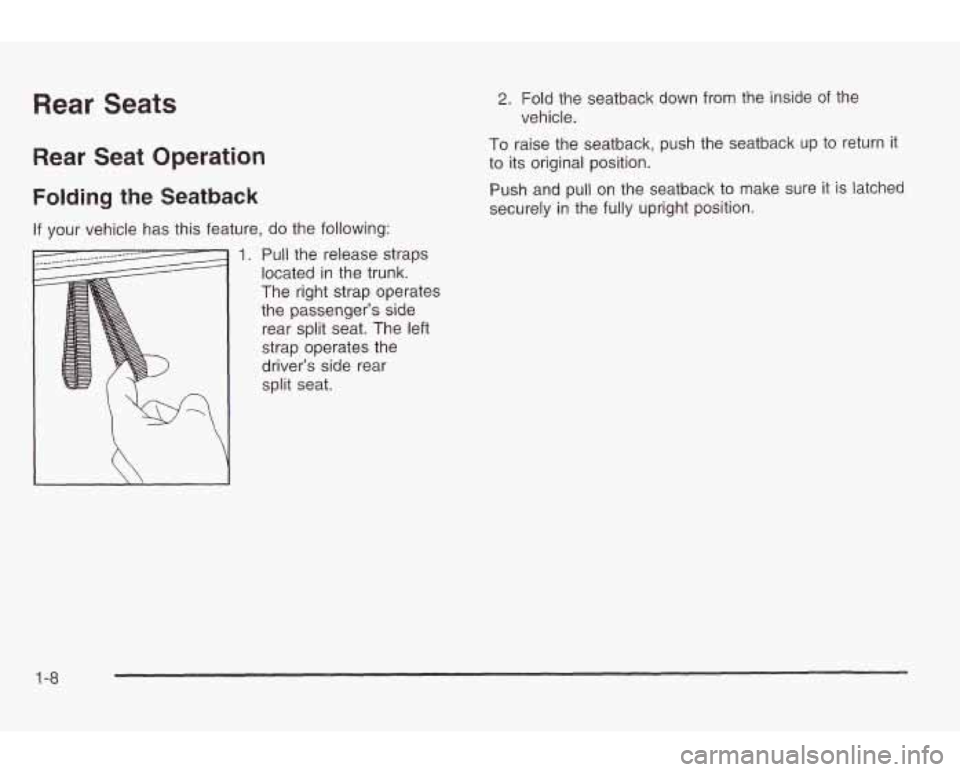seats PONTIAC GRAND AM 2003 Owners Manual
[x] Cancel search | Manufacturer: PONTIAC, Model Year: 2003, Model line: GRAND AM, Model: PONTIAC GRAND AM 2003Pages: 354, PDF Size: 16.3 MB
Page 2 of 354

The 2003 Pontiac Grand Am Owner Manual
Seats and Restraint Systems ........................... 1-1
Front Seats ............................................... 1-2
Rear Seats ............................................... 1-8
Safety Belts .............................................. 1-9
Child Restraints ....................................... 1-32
Supplemental Restraint
System
(SRS) ...................................... 1-53
Restraint System Check ............................ 1-60
Keys ........................................................ 2-2
Doors and Locks ....................................... 2-7
Theft-Deterrent Systems ............................ 2-1 7
Starting and Operating Your Vehicle ........... 2-18
Mirrors .................................................... 2-35
Sunroof .................................................. 2-38
Instrument Panel Overview .......................... 3-2
Climate Controls ...................................... 3-1 8
\Warning Lights, Gages a.nd Indicators ......... 3-22
Audio System@) ....................................... 3-38
Features and Controls ..................................... 2-1
Windows ................................................. 2-1 5
Stcr3.g~ .A rean ~ ................... 2-37 ..........
Instrument Panel ............................................. 3-1
Driving Your Vehicle ....................................... 4-1
Your Driving, the Road, and Your Vehicle ..... 4-2
Towing ................................................... 4-32
Service ..................................................... 5-3
Fuel ......................................................... 5-5
Checking Things Under
Service
and Appearance
Care .......................... 5-1
the Hood ............................................. 5-10
Bulb Replacement .................................... 5-49
Windshield Wiper Blade Replacement ......... 5-52
Tires ...................................................... 5-53
Appearance Care ..................................... 5-72
Vehicle Identification ................................. 5-80
Electrical System ...................................... 5-81
Capacities and Specifications ..................... 5-86
Normai iviainienance Fiepiawl I 1t.1-1; F&iJiS ...... 5-00 nn
Maintenance Schedule ..................................... 6-1
bhintenance Schedule ................................ 6-2
Customer Assistance Information .................... 7-1
Customer Assistance Information .................. 7-2
Index ............................................................... ..I
Page 8 of 354

Section 1 Seats and Restraint Sy
Front Seats ...................................................... 1.2
Manual Seats
................................................ 1.2
Reclining Seatbacks 1 -;j
Head Restraints ............................................. 1.5
Seatback Latches ........................................... 1-5
Easy Entry Seat ............................................. 1-6
Power Lift Seat
.............................................. 1-7
Rear Seats ....................................................... 1-8
Rear Seat Operation
....................................... 1.8
Safety Belts
..................................................... 1.9
Safety Belts: They Are for Everyone ................. 1-9
Questions and Answers About Safety Belts ...... 1-1 3
How
to Wear Safety Belts Properly ................. 1-14
Driver Position
.............................................. 1-1 4
Safety Belt Use During Pregnancy
.................. 1-22
Right Front Passenger Position ....................... 1-23
Rear Seat Passengers
.................................. 1.23
UGI 11G1 I IbUI I U~~~OILJUI VVI.~V. ...................... 1-27
Rear Safety Belt Comfort Guides for Children
and Small Adults
....................................... 1-29
Safety Belt Extender
..................................... 1-31
Child Restraints ............................................. 1.32
Older Children
.............................................. 1-32
Infants and Young Children
............................ 1-34
Child Restraint Systems ................................. 1-38
Six-Way Power Driver Seat
.............................. 1-3 ,-. ........................................
p-- +-v 0n-v Dnemnnnnr Dneitinn
Where to Put
the Restraint ............................. 1-41
Top Strap
.................................................... 1-42
Top Strap Anchor Location
............................. 1.43
Lower Anchorages and Top Tethers for
Children (LATCH System)
........................... 1 -44
Securing a Child Restraint Designed for the
LATCH System
......................................... 1-46
Securing a Child Restraint in a Rear Outside
Seat Position
............................................ 1-46
Securing a Child Restraint in a Center Rear
Seat Position
............................................ 1-48
Securing a Child Restraint in the Right Front
Seat Position
............................................ 1-50
System (SRS) ............................................. 1-53
When Should an Air Bag Inflate?
.................... 1-56
What Makes
an Air Bag Inflate? ..................... 1-57
What Will You See After an Air Bag Inflates? ... 1-58
Servicing Your Air Bag-Equipped Vehicle
......... 1-59
Restraint System Check
.................................. 1-60
Checking Your Restraint Systems
................... 1-60
Repiacing Resirzlint System Parts
After a Crash ............................................ 1-61
Supplemental Restraint
Where Are the Air Bags?
............................... 1-55
nuw Lues 5i-l Ail- Ea9 ECS~E~G? ..................... 157’
1-1
Page 9 of 354

Front Seats
Manual Seats
You can lose control of the vehicle if you try to
adjust a manual driver’s seat while the vehicle
is moving. The sudden movement could startle
and confuse you,
or make you push a pedal
when
you don’t want to. Adjust the driver’s
seat only when the vehicle is not moving.
Lift the bar located under the front
of the seat to unlock
it. Slide the seat to where you want
it and release
the bar.
Try to move the seat with your body to be sure
the seat is locked in place.
1 -2
Page 15 of 354

Rear Seats
Rear Seat Operation
Folding the Seatback
If your vehicle has this feature, do the following:
2. Fold the seatback down from the inside of the
vehicle.
To raise the seatback, push the seatback up
to return it
to its original position.
Push and pull on the seatback
to make sure it is latched
securely in the fully upright position.
1. Pull the release straps
located in the trunk.
The right strap operates
the passenger’s side
rear split seat. The left
strap operates the
driver’s side rear
split seat.
1-8
Page 16 of 354

Safety Belts
Safety Belts: They Are for Everyone
This part of the manual tells you how to use safety
belts properly. It also tells you some things you should
not
do with safety belts.
A I I
CA UTl0,N:
Don’t let anyone ride where he or she can’t
wear a safety belt properly. If you are in a
crash and you’re not wearing a safety belt,
your injuries can be much worse. You can hit
things inside the vehicle or be ejected from
it.
You can be seriously injured or killed. In the
same crash, you might not be, if you are
buckled up. Always fasten your safety belt,
ana cneck
tnai your passengers’ Leiis art:
fastened properly too.
It is extremely dangerous to ride in a cargo
area, inside
or outside of a vehicle. In a
collision, people riding in these areas are more
likely to be seriously injured or killed.
Do not
allow people to ride in any area of your vehicle
that
is not equipped with seats and safety
belts. Be sure everyone in your vehicle
is in a
seat and using a safety belt properly.
1-9
Page 21 of 354

Q: If I’m a good driver, and I never drive far from
home, why should
I wear safety belts?
A: You may be an excellent driver, but if you’re in an
accident
- even one that isn’t your fault - you and
your passengers can be hurt. Being
a good
driver doesn’t protect you from things beyond your
control, such as bad drivers.
Most accidents occur within 25 miles (40 km)
of home. And the greatest number of serious
injuries and deaths occur at speeds of less than
40 mph (65 km/h).
Safety belts are for everyone.
How to Wear Safety Belts Properly
This part is only for people of adult size.
Be aware that there are special things
to know about
safety belts and children. And there are different
rules for smaller children and babies.
If a child will be
riding in your vehicle, see
Older Children on page 1-32
or lnfants and Young Children on page 1-34. Follow
those rules for everyone’s protection. First,
you’ll want
to know which restraint systems your
vehicle has.
We’ll start with the driver position.
Driver Position
This part describes the driver’s restraint system.
Lap-Shsulder Belt
The driver has a lap-shoulder belt. Here’s how to wear it
properly.
1. Close and lock the door.
2. Adjust the seat so you can sit up straight. To see
how, see
Manual Seats on page 1-2 or Six-Way
Power Driver Seat on page 1-3.
1-14
Page 36 of 354

Rear Safety Belt Comfort Guides for
Children and Small Adults
Your vehicle may have this feature already. If it doesn’t,
you can get it from any
GM dealer.
Rear shoulder belt comfort guides will provide added
safety belt comfort for older children who have outgrown
booster seats and for small adults. When installed on
a shoulder belt, the comfort guide better positions
the belt away from the neck and head.
There is one guide available for each outside passenger
position in the rear seat. To provide added safety belt
comfort for children who have outgrown child restraints
and booster seats and for smaller adults, the comfort
guides may be installed on the shoulder belts. Here’s
how to install a comfort guide and use the safety belt:
1. Pull the elastic cord out from between the edge of
the seatback and the interior body to remove the
guide from its storage clip.
1-29
Page 39 of 354

Child Restraints
Older Children
Older children who have outgrown booster seats should
wear the vehicle’s safety belts.
Q: What is the proper way to wear safety belts?
A: If possible, an older child should wear a
lap-shoulder belt and get the additional restraint
a
shoulder belt can provide. The shoulder belt
should not cross the face or neck. The lap belt
should fit snugly below the hips, just touching the
top
of the thighs. It should never be worn over
the abdomen, which could cause severe or even
fatal internal injuries in a crash.
Accident statistics
show that children are safer if they
are restrained in the rear seat.
In a crash, children who are not buckled up can strike
other people who are buckled up, or can be thrown
out of the vehicle. Older children need
to use safety
belts properly.
If you have the choice, a child should sit next to a
window
so the child can wear a lap-shoulder belt and
get the additional restraint a shoulder belt can provide.
1-32
Page 46 of 354

A forward-facing child seat (C-E) provides restraint for
the child's body with the harness and also sometimes
with surfaces such as T-shaped or shelf-like shields. A booster seat (F-G) is a child restraint designed to
improve the fit of the vehicle's safety belt system. Some
booster seats have a shoulder belt positioner, and
A booster seat can also help a child to see out the
window.
sui-,-,E: ;-,iy;-,-lcacl\: bclclster se6is klzv.e ;;.",e-pG;rlt p,zrrless~
1-39
Page 57 of 354

To remove the child restraint, just unbuckle the vehicle’s
safety belt.
It will be ready to work for an adult or
larger child passenger.
Securing a Child Restraint in the
Right Front Seat Position
Your vehicle has a right front passenger air bag.
Never put a rear-facing child restraint in this seat.
Here’s why:
A child in a rear-facing child restraint can be
seriously injured or killed if the right front
passenger’s air bag inflates. This is because
the back of the rear-facing child restraint
would be very close to the inflating air bag.
Always secure a rear-facing child restraint in a rear seat.
I I
Although a rear seat is a safer place, you can secure a
forward-facing child restraint in the right front seat.
You’ll be using the lap-shoulder belt. See
Top Strap on
page 1-42, if the child restraint has one. Be sure to
follow the instructions that came with the child restraint.
Secure the child in the child restraint when and as
the instructions say.
1. Because your vehicle has a right front passenger
air bag, always move the seat as far back as
it will
go before securing a forward-facing child restraint.
See
Manual Seats on page 1-2.
2. Put the restraint on the seat.
1-50